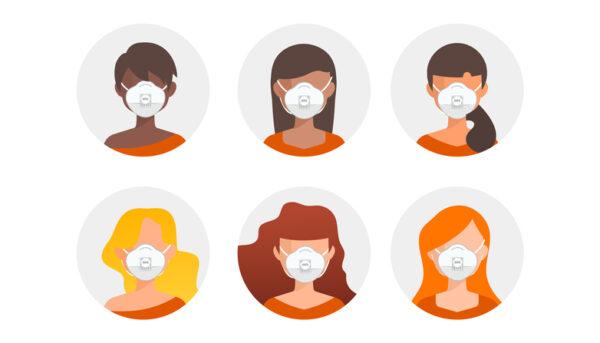
Different race people in medical masks on a white background. Quarantine concept. Novel coronavirus 2019-nCoV, vector illustration
The Covid-19 pandemic has illuminated the reality of medical racism. Research from Johns Hopkins University found that Covid-19, as well as its long-term effects, are amplified by structural racism and discrimination. Firstly, Black, Hispanic and Native American workers were most likely to be employed in sectors such as restaurants, travel, retail and manufacturing which were disproportionately affected by the pandemic. Due to the existing health inequities of the medical system, minority patients were also more reluctant to seek out care. Furthermore, when members of the Black, Hispanic and Native American populations developed a Covid-19 infection, they were at a higher risk of morbidity and mortality.
Even if patients experienced a mild Covid-19 case, they were still at risk for developing symptoms that persist long after their initial diagnosis. This group of people is known as Covid long-haulers, and their condition is often called Long Covid. Early in the pandemic, Long Covid was poorly understood, and many doctors did not believe it existed, nor did they have the proper resources to formally diagnose it. Complicating the matter, experts believe that minority patients may be at the greatest risk for Long Covid. Without a Long Covid diagnosis, it is difficult for patients to obtain proper care, participate in Long Covid research studies, take sick days from work to rest – the primary recommended treatment – or obtain disability benefits.
It wasn’t until June 14, 2021 that the U.S. Centers for Disease Control and Prevention finally published its guidance for diagnosing this condition. Without concrete guidance on how to diagnose and treat this condition, many minority patients’ symptoms were dismissed, and it further marginalized patients who already faced barriers to receiving health care.
Racism’s role in health care treatment
Racism in medicine is not a new topic. In fact, research finds that both medical diagnostics and physician perceptions are imbued with racism. Medical diagnostics may look “objective,” but they can include baked-in racism. For example, race factors into kidney function measurement, so Black patients are less likely to receive a kidney transplant than White patients. As a result, while Black Americans constitute more than one-third of dialysis recipients, they only receive one in five of every kidney transplants.
What’s more, physicians’ biases may unwittingly harm marginalized patients. False beliefs about pain tolerance mean that some doctors under prescribe painkillers to Black patients. In fact, Dr. Susan Moore, a black physician who was hospitalized in December of 2020 with Covid-19 took to Facebook with a video recorded on her smartphone that went viral. In the video, she detailed her doctor’s unwillingness to prescribe medication for her Covid-related pain. After asking to be transferred to another hospital, she was ultimately discharged – and soon readmitted to another ICU, where she died.
An understanding of patients’ background and culture – what’s known as cultural competency –plays an important role in health care. For example, when Black patients see Black doctors, they are more likely to adhere to their doctor’s recommendations for lifesaving preventive care. One can also see the importance of cultural competency in health care historically: In the 17th century, community midwives served pregnant Black, indigenous and immigrant women. Midwives apprenticed informally and understood the culture and traditions of their patients. In the 1920s, new midwife licensing eliminated the apprenticed midwives. Nowadays, pregnant Black women often choose to escape at least one aspect of racism in their obstetrics care by choosing Black doctors.
Modeling hospitals after high-reliability organizations
One way to reduce discrimination in medicine is for hospitals, clinics and other medical groups to cultivate the attributes of a high-reliability organization, or HRO, loosely defined as “organizations that operate in complex, high-hazard domains for extended periods without serious accidents or catastrophic failures.”

A classic example of an HRO can be found in the airline industry. Airplane pilots, for example, are tasked with long checklists to make sure everything goes well on their flight, because not following the rules can lead to disaster. A doctor’s office that functions as an HRO works similarly. In the pandemic, this would mean maintaining cleanliness, washing hands and wearing masks. A medical office functioning as an HRO knows exactly what to tell patients to help them have the best standard of care. Medical HROs do not ignore patients, instead, they talk directly with the patient and center them in the care process. Everyone’s opinions and viewpoints, regardless of their status, is valued in an HRO.
Operating like an HRO can help break down the traditional hospital hierarchies which typically value seniority over experience. In the clinic, an attending physician oversees doctors-in-training: residents, interns and medical students. Attendings are decision-makers and historically, observations from junior colleagues — including from medical residents often go ignored. Patients’ concerns can go unheard, whether they are intimidated by medical staff, or dismissed by health care staff. This means that valuable insights from junior colleagues are often disregarded in the healthcare setting, which undermines the standard of care for everyone – not just marginalized patients.
Furthermore, HROs are cognizant of their actions and are characterized by a high level of both transparency and accountability. Just as an airline may rely on data to make safety decisions, so, too, can medical enterprises harnessing 21st century data collection and analysis to learn about drivers of healthcare outcomes in marginalized patients.
Modeling health care after HROs can help reduce harm by standardizing the way care is provided and identifying and mitigating sources of bias that can disenfranchise marginalized patients. These sources of bias are often shrugged off, or complainants may even experience backlash. Unfortunately, such a culture of fear and silence has catastrophic consequences.
Adopting a HRO model can seem overwhelming, but Actionable Patient Safety Solutions (APSS), free, comprehensive patient safety curriculum, makes it possible. These checklist-style protocols for hospital procedures resemble airplane pilot procedures. The APSS also tackles cultural aspects of patient care and discusses the importance of a culture of communication, in which both patients and healthcare workers can voice their concerns and break out of a toxic culture of silence and fear.
Without efforts to make hospitals run more like HROs, the healthcare system will continue to harm minorities.
Photo: Irina Shatilova, Getty Images
Promoted
Healthcare industry is transitioning to value-based care models. That’s why the medical deviceindustry's ability to continue the development of life-changing innovations will rely ondemonstrating how new technology fits under this value-based paradigm. To build future-ready solutions, it’s important to focus on choosing the right tools and technology partners. The Innovaccer Health Cloud is well-positioned to do just that!
Innovaccer's Rishav Krishna & Smriti Khera
Promoted
Formlabs is sponsoring a webinar exploring 3D printing from clinical, commercial, and regulatory perspectives. Join us on April 6th!